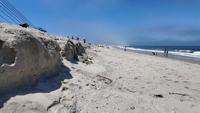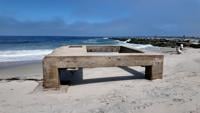SUSSEX COUNTY, De. -- The north beach at the Indian River Inlet looks much different than it did just a few months ago. Natural causes have quickly undone the work of 480,000 cubic yards of sand pumped onto the beach in late 2024 and early 2025.
Officials with the Delaware Department of Natural Resources and Environmental Control (DNREC) attribute the loss of sand to the natural sand transport system known as littoral drift, as well as from recent storms and high waves.
Beachgoers, especially those like Richard Horner, who has already been on the north beach multiple times this year, are taking notice.
"Well, in March, it was probably, the beach was probably 30 yards in front of that big cement foundation, now it's probably like 10 yards. That cement foundation was completely covered," said Horner, referring to a large piece of cement foundation that is now sticking up out of the sand.
That foundation, along with a noticeable, multi-foot-high shelf, has presented people with a clear visual idea of just how severe the erosion problem is.
"It seems like every year we're losing a little bit of beach to sit on," said Brianna Bender. "We have limited areas to lay everything out and it just seems like it's changing so much all the time."
Locals like Bill Medford, who surfs at the north beach multiple times a week, are clamoring for a permanent fix.
"Either continue dredging from the south side and pumping sand year-round or a permanent fix of the jetty," said Medford. "They're not addressing it in the long term; it seems to me as if they're band-aiding it year after year."
DNREC said it expects some of the sand to return to shore naturally via an ebb shoal offshore.
The US Army Corps of Engineers is also expected to begin Phase II of the north beach nourishment project in late August or early September. The USACE has a goal of pumping an additional 300,000 cubic yards of sand from the ebb shoal to go along with the 480,000 cubic yards pumped throughout late fall and winter.




